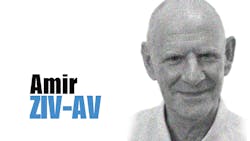Getting the Best Design Concept
This file type includes high resolution graphics and schematics when applicable.
Engineers and product development teams often struggle when deciding which concepts and designs to invest time and money into developing and which to discard. Dr. Amir Ziv-Av offers advice on how engineers can choose the right designs and optimize them into successful products on the marketplace. Ziv Av is founder and chairman of Ziv-Av Engineering in Israel. His firm provides outsourcing services to companies that are designing and manufacturing products and multi-disciplinary systems. They also advise manufacturers on ways to design, make, and deliver better products.
How would you define an optimal product and how does that relate to its design?
The optimal product provides the best response to product requirements…or it is simply the most cost-effective product that can be developed within the constraints of time and budget. Based on studies, a product’s success depends almost entirely on its design concept and requirements. Together the concept and requirements constitute a product’s strategy—or in other words, its “general direction”—as opposed to the detailed design or tactic. And a well thought out concept includes the product’s general configuration, principles of operation, technological discipline, module distribution and interfaces between them.
Product development is an iterative process, so it is difficult, if not impossible, to correct the general direction or strategy once the process begins. Details, however, can be changed or corrected.
How should a design team prioritize product requirements?
Prioritizing the relative importance of various requirements affects the product’s concept and its requirements, as well as the design details. So prioritizing requirements can change the final product radically.
Requirements are usually divided into two groups: “customer” and “value chain” requirements. Customer requirements include areas of performance and price, while value chain requirements involve complexity and cost. Examples of customer requirements for a vehicle might include speed, safety, stability, purchase price, and operating cost. Value chain requirements would include minimum number of parts, maximum use of standardized parts, minimum investment in development, and shortest minimum time to market. Requirements must be balanced as well as prioritized. This means key requirements should be broken down into sub-requirements and weighted accordingly.
When should the design team freeze the design?
One of the main challenges in the development process is deciding when to freeze development. In other words, at what stage is the team confident that the proposed product will comply with its requirements? Part of the confidence should stem from theoretical analysis and calculation, and the rest of the confidence should stem from experimental product testing. But calculations and experiments are usually carried out under specific conditions, whereas the product will get exposed to unknown conditions.
A common compromise is to perform experiments under extreme conditions and even combine experiments.
This, however, can lead to a trap. For example, a team might simultaneously expose a mechanism to a corrosive environment to prove it can withstand it and to extreme vibrations to prove strength and durability. Combining the two experiments may result in a faulty conclusion, because vibrations might prevent the mechanism from getting stuck due to corrosion.
How can design teams be made more receptive to good ideas from outside the team and overcoming the “not-invented-here" (NIH) syndrome?
These are psychological problems and are based on the prevalent behavior of most people and organizations to attribute increased value to their knowledge and ideas while underestimating those of colleagues outside the organization. The solution is to increase the methodological and objective aspect of product development process, and, in parallel, reduce the intuitive and emotional part of the process.
Is it possible for a design team to come up with an optimal concept but then not be able to execute it?
Yes. In many cases, teams reach the best concept but cannot use it for lack of technological skill or limited resources. For example, one good approach to building an electrical vehicle involves four wheel-hub motors. But this means it cannot be realized by modifying the current design of a conventional vehicle. So going with hub motors would require a $3-billion investment to get to mass production. As a result, most car makers choose concepts for news cars and types of powertrains based on their existing line of vehicles.
This file type includes high resolution graphics and schematics when applicable.


